| 4000 Yankees Attack Canada |
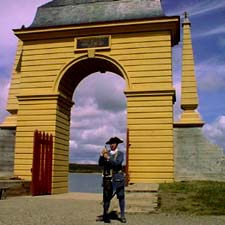
PEPPERRELL AT LOUISBOURG
We won. But can you name the first major military victory in American history? It made England rejoice, France despair and set the wheels in motion for an American Revolution three decades later. And it all started here.
READ: Great Myths of Canada
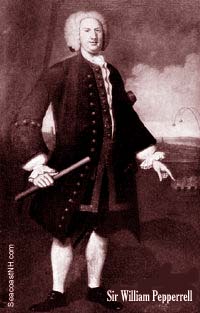 The first major military victory in New Hampshire history is all but forgotten. We won for England in 1745. The French lost. The New England attack on Fort Louisbourg was lead by a Kittery general, the richest man around. A thousand Yankees were left behind, dead largely from disease and exposure. And New Englanders learned an important lesson – they could fight if called upon.
The first major military victory in New Hampshire history is all but forgotten. We won for England in 1745. The French lost. The New England attack on Fort Louisbourg was lead by a Kittery general, the richest man around. A thousand Yankees were left behind, dead largely from disease and exposure. And New Englanders learned an important lesson – they could fight if called upon.
New Englanders from the Piscataqua region attacked Canada in 1745 -- and won. The largest colonial militia ever assembled in the New World to that date, 4,000 men, lay siege to the great walled French city at Louisbourg until the fortress fell. Thousands of French citizens who occupied the strategic port on what is now Cape Breton Island were shipped home to France. Nearly 1,000 New Englanders -- men of Maine, New Hampshire, Massachusetts, Rhode Island and Connecticut -- died at Louisbourg, most from exposure and disease, and their bones can still be found in the nearby Nova Scotia fields.
Yet it's difficult to fathom the impact of the Louisbourg victory today. Life-sized full-length paintings of both winning generals loom over the reading room just inside ornate doors of the Portsmouth Athenaeum. On the left is a dully-dressed British admiral Sir Peter Warren. To his right, an oddly- shaped man with a bright red suit and Richard Simmons haircut commands attention.
"Who is he?" visitors inevitably ask, looking up at the uniformed figure, bombs bursting in mid-air behind him.
"That’s Sir William Pepperrell of Kittery, Maine," a learned guide will answer. "He won the siege at Louisbourg."
"Uh-huh," the visitor says, and that's often the end of it. The battle that helped define colonial New England has all but passed from local memory.
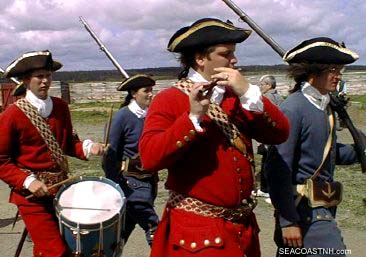
The first problem with Louisbourg is geography. We defeated New France? Where was that? In Cape Breton? The second problem is alliance. First we were fighting the French and Indian Wars, then suddenly the French were our allies against the British in the American Revolution. Then we got mired in a Quasi-War with France. Go figure. The third problem is timing. In 1745 at the defeat of Louisbourg, New Englanders were British subjects, not yet full-fledged flag-waving American patriots. Maine was still part of Massachusetts and William Pepperrell (eventually the first colonial ever knighted by the British crown) was arguably the richest man in North America. Unassuming and likeable, Pepperrell was a successful merchant and judge. Heir to his father's fortune, native-born Pepperrell could walk from Kittery to Saco, Maine without ever stepping off his own land. But our national memory for heroes prior to the Revolution is short.
Continue with FORT LOUISBOURG
New England Raids Fort Louisbourg 1745
With France and England again at war in 1744, somebody had to rout the enemy from its Canadian stronghold. Pepperrell, at first, flatly declined the job. But Royal Governor William Shirley of Massachusetts pressed harder. No one in New England had more resources and a better reputation. Pepperrell relented, but still had to convince enough men to do the job in an era with no standing colonial army.
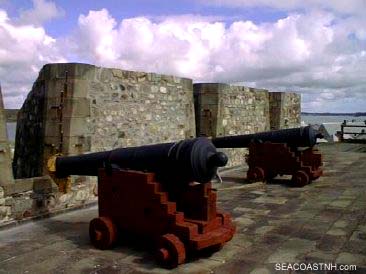
As American presidents do so well today, Shirley launched a pre-war propaganda campaign. The well-built French station at Louisbourg was a palpable threat to the lives of every New Englander, he explained. If we did not take the French out first, they might come for us. A pre-emptive strike was the only solution.
Certainly the large stone fortress did give the French (who had arrived there in the late 1500s well before the British) power along the St. Lawrence River and access all the way to the Great Lakes. Yes, the troops at Louisbourg had recently attacked the British outpost at Canso in nearby Nova Scotia. Yes, a few Maine towns had been terrorized by marauding French warships. But it wasn't until French privateers stationed at Louisbourg began picking off New England fishing boats and merchant ships that the locals took notice. Fish were to 18th century economics what oil is today, and the Grand Banks were loaded with fish. So the men of New England signed on with Gen. Pepperrell for $25 per month and a free blanket per man. Ultimately, it was the lure of looting Louisbourg that brought many aboard the transport ships.
And one more thing – largely Protestant New Englanders were quite certain that God favored them over the Catholic French. Louisbourg made an ideal proving ground for the Almighty to make His will known.
Although Admiral Peter Warren became an English hero after the siege, much of the credit for victory must go to Pepperrell. According to Joe Frost of Eliot, Maine, a direct descendant, Sir William was a truly popular guy, a man's man. It was an era, unlike today, when the chief commander actually went to war. Although in his early 50s, Pepperrell personally accompanied his rag-tag militia of farm boys and fishermen, often speaking to them directly, running the show with a loose hand.
The French were expecting British naval reprisals. The star-shaped fortress at Louisbourg had been built for just that purpose. What they hadn't expected was the sheer number of plucky New Englanders who sailed to the defense of their precious fishing grounds. They hadn't expected the troops to begin the siege by land, quickly knocking out the Royal Battery, the weakest defense point, and turning the French cannons on the city.
Luckily for the French, there were few trained gunners. Cannon were as likely to explode as to fire on target. For many New Englanders, the trip was, initially, more like a holiday, than war. Men who were not misfiring the cannons might be wrestling, drinking, wasting ammunition with target practice, raiding local homes or playing an early version of tennis -- much to the chagrin of their general -- who dared not inflict harsh discipline for fear of losing control.
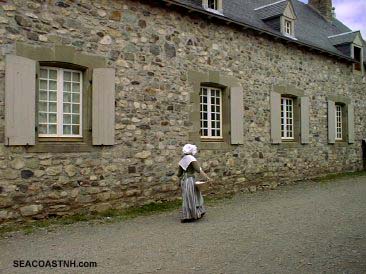
Life inside the fortress of Louisbourg was harsh even in the best of times with killing Nova Scotian winters and the cutting Atlantic winds. Food was always in short supply and the reluctant French soldiers defending the populace were often ragged, over-worked and poorly trained. Pepperrell and Warren, who often disagreed on strategy, knew a great deal about the workings and layout of the fortress. New England and British traders, defecting French soldiers and exchanged prisoners had documented its weaknesses. Highest on the list were low soldier morale and crumbling fort walls rebuilt with wood. Worst, the whole city was vulnerable from a high ground attack on the King's Bastion.
Continue with FORT LOUISBOURG
New England Raids Fort Louisbourg 1745
So that's where Pepperrell eventually attacked, dragging cannon over swampy areas thought impossible to navigate. The siege itself lasted 45 days, from the end of May until the 7th of July. A steady rain of shot battered the walls and terrorized civilians. French accounts offer horrible details of suffering townspeople. One report tells of a baby, blown to pieces while sitting in his father's lap. The father was untouched, but the cannon ball passed through a wall, killing two more children.
Soldiers on both sides of the battle were often so close they could taunt eachother over the collapsing walls. Yankees offered the starving French some of King George’s bread and asked if there were any good-looking girls in side. "Come in and see for yourself!" the French called back.
Just 100 New Englanders died in battle, 60 of those in an abortive night raid to storm the badly damaged Dauphin's Gate. At the first attempt, the moon was too bright. At the second, the officers in charge did not show. At the third, the men were too drunk to row. In the fourth, a noisy New Englander alerted French sentries who killed or captured most in the raiding party.
In the end, the greater luck was with New England. After Warren captured a critically important French supply ship and Pepperrell got his cannons to the high ground, the handwriting was on the fortress wall. The French surrendered to the British king. But it was the end of luck for the men of New England. The farmer boys and fishermen who won the day were then required to hold the fortress until the British regulars arrived. They did not arrive until the following Spring of 1746. Through the winter as many as 17 men died per day, a total of 800 Yankees dead and over 1,000 ill from cold and disease. Too tired and weak even to dig graves, New Englanders dropped the corpses of comrades beneath the floorboards of abandoned French homes.
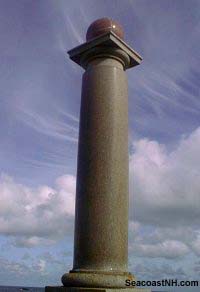 Three years after the battle of Louisbourg, in a political maneuver, the British gave the fortress back to the French. This greatly angered the residents of New England, already ired by the needless loss of Yankee life following the siege. The men of New England, tested at Louisbourg, felt a growing territorial pride and a sense of American, not British, nationalism. With little more than willpower, New England had defeated a supposedly invincible foe. Evolving from a raucous gang of privateers, the colonies had worked together, been tested, and emerged more united.
Three years after the battle of Louisbourg, in a political maneuver, the British gave the fortress back to the French. This greatly angered the residents of New England, already ired by the needless loss of Yankee life following the siege. The men of New England, tested at Louisbourg, felt a growing territorial pride and a sense of American, not British, nationalism. With little more than willpower, New England had defeated a supposedly invincible foe. Evolving from a raucous gang of privateers, the colonies had worked together, been tested, and emerged more united.
Almost bankrupted by the costly raid, New Englanders finally collected the debts of war from Britain. Sir William Pepperrell eventually got Shirley’s old job and was appointed royal governor of Massachusetts. When, a few years later, the British again battled France and retook Louisbourg and razed it to the ground, he was appointed Lieutenant General, but died in 1759 and was buried in Kittery. Following the second siege, the ruins of Louisbourg lay almost forgotten until a small museum was dedicated on the distant Cape Breton site in the early 20th century. An obelisk, raised near a rocky beach by Americans in 1895, is the only memorial to the Yankee dead.
And that would be the whole story, a footnote in the high school history texts of four nations. Then in the 1960s the Canadian government authorized a bold $25 million restoration project, the largest ever seen in North America at the time. Fortress Louisbourg has been rebuilt, timber by timber, stone by stone. Today one-fifth of the entire city stands on its original foundations, scrupulously renovated from millions of documents found in French archives.
Today Cape Breton re-enactors, men, women and children, walk purposefully through the streets of the fortress – feeding animals, baking bread, serving meals, guarding the gates. It is, for them, 1744 – the fateful year before the men from New England will arrive. Visiting Louisbourg is as close to the real thing as imagination gets – far more authentic than anything a Hollywood film or theme park can deliver.
Among the souvenirs taken from the first siege, according to historian Joe Frost, was the bell from a Louisbourg church. One of Pepperrell’s men donated the bell to the Queen’s Chapel, what is today St. John's Episcopal Church in Portsmouth. When St. John's burned in 1806, the Louisbourg bell was sent to Paul Revere in Boston for repair. Today the name Paul Revere still rings a bell with all Americans, while the bell from the Seige of Louisbourg jogs few memories in Portsmouth. Even the great Pepperrell legacy remains as foggy as the view from a Nova Scotian bay.
SOURCES & FURTHER READING: Louisbourg Colourguide by Susan Biagi (2001), Louisbourg From its Foundations to its Fall by JS, McLennan (1918), New Englanders Take Louisbourg (Cape Breton's Magazine, 1998), Sir William Pepperrell by Neil Rolde (1982), Yankees at Louisbourg by George Rawlyk (1999).
Copyright © 2006 by J. Dennis Robinson. All rights reserved. Dennis Robinson is editor and owner of the Seacoast web site SeacoastNH.com.
